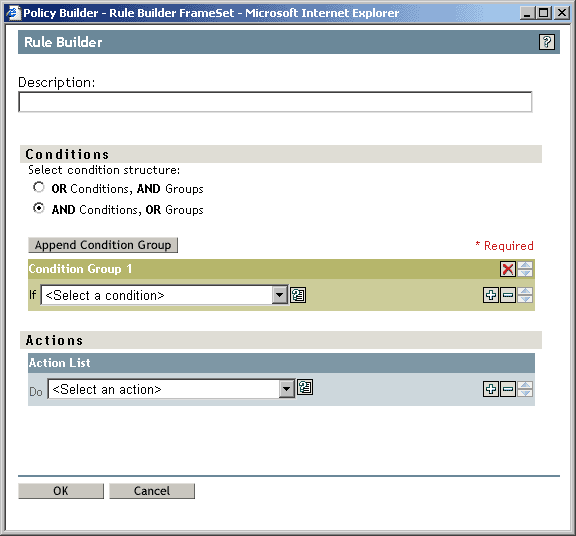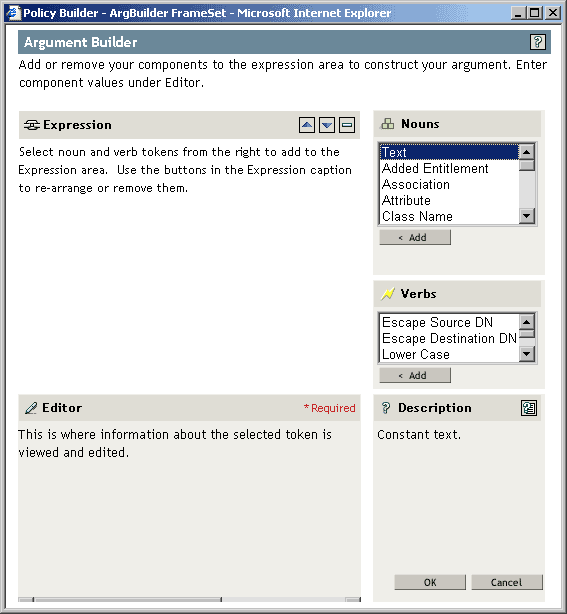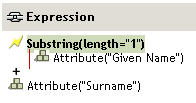In iManager, expand the DirXML® Management Role, then click Overview.
Specify a driver set.
Click the driver for which you want to manage policies. The DirXML Driver Overview opens:

Policies are managed from the DirXML Driver Overview.
This section contains instructions on performing common tasks in Policy Builder:
In iManager, expand the DirXML® Management Role, then click Overview.
Specify a driver set.
Click the driver for which you want to manage policies. The DirXML Driver Overview opens:

Policies are managed from the DirXML Driver Overview.
Open the DirXML Driver Overview for the driver you want to manage.
Click the icon representing the policy you want to define.
![]() represents an undefined policy.
represents an undefined policy.
![]() represents a defined policy.
represents a defined policy.
Click Insert.
Enter a name for the new policy, then select Policy Builder.
The policy is displayed. To define one or more rules for this policy, click Append New Rule, then follow the instructions in Defining Individual Rules within a Policy.
Rules are defined in the Rule Builder window of Policy Builder:

The Rule Builder interface enables you to quickly create and modify rules using intelligent drop-down menus.
In Rule Builder, you define a set of conditions that must be met before a defined action occurs.
For example, if you needed to create a rule that disallowed any new objects from being added to your environment, you might define this rule similar to the following: When an add operation occurs, veto the operation.
To implement this logic in Rule Builder, you could select the following condition:

And the following action:

See Conditions and Actions or a detailed reference on the conditions and actions available in the Rule Builder.
To create more complex conditions, you can join conditions and groups of conditions together with and/or statements. You can modify the way these are joined by selecting the condition structure:

Click the  icon to see a list of values for a field. In the example above, this icon opens a list of valid class names.
icon to see a list of values for a field. In the example above, this icon opens a list of valid class names.
Click the  icon to use the Argument Builder interface to construct an argument.
icon to use the Argument Builder interface to construct an argument.
Click the  icon to disable a policy, rule, condition, or action. Click the
icon to disable a policy, rule, condition, or action. Click the  icon to re-enable it.
icon to re-enable it.
Click the  icon to add a comment to a policy or rule. Comments are stored directly on the policy or rule, and can be as long as necessary.
icon to add a comment to a policy or rule. Comments are stored directly on the policy or rule, and can be as long as necessary.
Use the Cut/Copy/Paste icons, ![]() , to use the Policy Builder clipboard. The Paste icon is disabled if the current content on the clipboard is invalid at that location.
, to use the Policy Builder clipboard. The Paste icon is disabled if the current content on the clipboard is invalid at that location.
Use the  icons to add, remove, and position conditions.
icons to add, remove, and position conditions.
Use the  button add condition groups.
button add condition groups.
Use the  icons to remove, and position condition groups.
icons to remove, and position condition groups.
Argument Builder provides a dynamic, graphical interface which enables you to construct complex argument expressions for use within Rule Builder:

To define an expression, select one or more nouns (values, objects, variables, etc.), and combine them with verbs (substring, escape, upper and lower case) to construct arguments.
Multiple nouns, verbs, and expressions are combined to construct complex arguments.
For example, if you would like the argument set to an attribute value, you simply select the attribute noun, and enter or select the attribute name:

If you only want a portion of this attribute, you can combine the attribute noun with the substring verb:

See Nouns and Verbs for a detailed reference on the nouns and verbs available in the Argument Builder.
To create more complex conditions, you can join conditions or groups of conditions together with and/or statements.
Use the  icons to move and delete nouns and verbs.
icons to move and delete nouns and verbs.
Click the  icon to see a list of values for a field.
icon to see a list of values for a field.
After you add a noun or verb, you can provide values in the editor then immediately add another noun or verb. You do not need to refresh the Expression pane to apply your changes, they appear when the next operation is performed.
Although you define most arguments using this standard interface, there are a few other custom Argument Builder windows used to provide information in certain circumstances. Several of these windows launch the default Argument Builder to provide values.
The following sections contain an explanation of these additional Argument Builder interfaces and the conditions and actions which use them:
The Matching Attribute Builder is used to construct conditions to satisfy a Find Matching Object action.

The Argument Actions Builder is used to construct a list of actions to take in actions such as For Each.

The Named String Builder is used to create name/value pairs for use in Actions such as Generate Event and Send Email.

The Argument Value List Builder is used to create arguments for actions such as Set Default Attribute Value. In this example, a string argument with the value unknown has been created to set the default location.

Open the DirXML Driver Overview for the driver you want to manage.
Click the icon representing the policy you want to modify.
Select the policy you want to modify, then click Edit.
Open the DirXML Driver Overview for the driver you want to manage.
Click the icon representing the policy you want to delete.
Select the policy you want to delete, then click Remove.
Open the DirXML Driver Overview for the driver you want to manage.
Click the icon representing the policy you want to delete.
Edit an existing policy, or create a new policy.
Click the Insert button, and select Import an XML file containing DirXML Script.
Browse to the policy file to import, then click OK.
Open the DirXML Driver Overview for the driver you want to manage.
Click the icon representing the policy you want to delete.
Edit an existing policy, or create a new policy.
Click the Save As button, then select a location to save the DirXML Script XML file.
A policy reference enables you to create a single policy, and reference it in multiple locations. If you have a policy that is used by more than one driver or policy, creating a reference simplifies management of this policy.
Open the DirXML Driver Overview for the driver you want to manage.
Click the icon representing the policy you want to delete.
Edit an existing policy, or create a new policy.
Click the insert button, and select Append a reference to a policy containing DirXML Script.
Browse to the policy object to reference, then click OK.